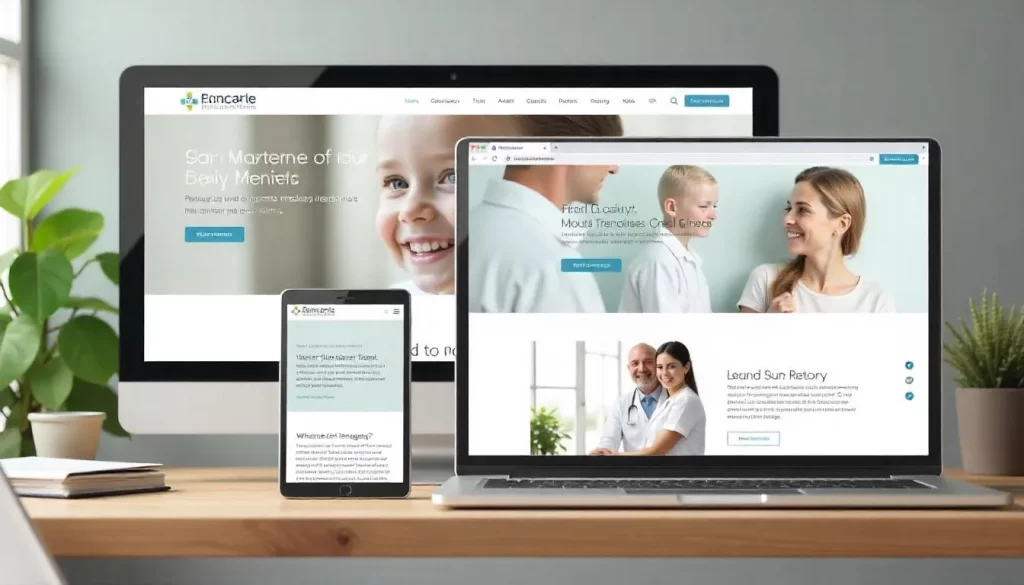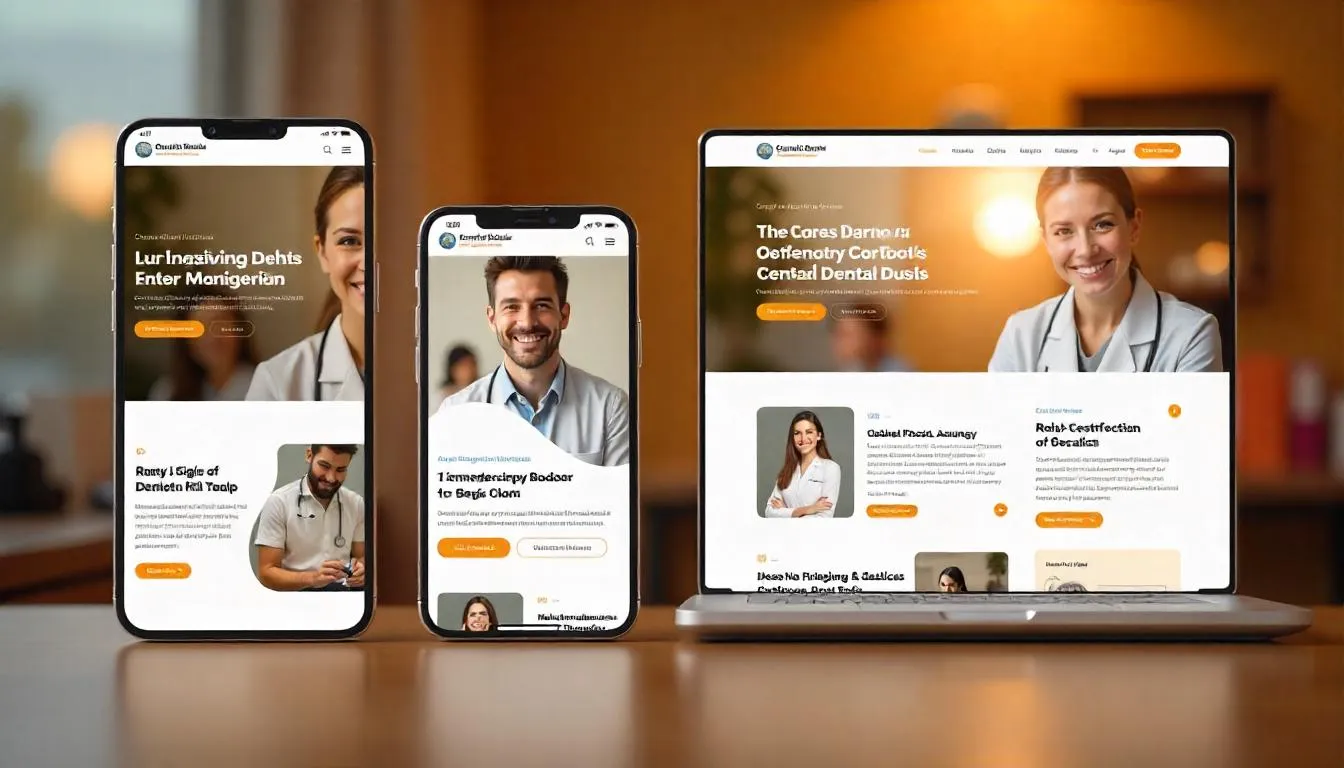Why Dental Website Design Matters for Practice Growth
In today’s digital age, your dental website is the front door to your practice. It’s the first impression potential patients will have of your services, and it plays a critical role in building trust, establishing authority, and driving practice growth. A well-designed dental website is not just a marketing tool; it’s a vital asset to your practice’s success. But how exactly does it impact your growth?
We’ll explore how your dental website design affects patient trust, lead generation, and branding. We’ll break down the key elements of a professional dental website and provide actionable advice on leveraging design for practice growth.

Related Posts
- Back-End Essentials for Reliability, Compliance, and Trust
- Why Most Dental Website Traffic Comes from Mobile and How to Optimize
- Adapting Design to Specific Practice Types
How Your Website Impacts Patient Trust and Branding
The Role of First Impressions
As the digital face of your practice, your dental website is often the first interaction a potential patient has with your services. A professional, well-designed website can go a long way in fostering trust. Think about it: a clean, modern design can communicate competence and professionalism, while a cluttered or outdated website might give the impression that your practice is behind the times.
Expert Insight: When a patient visits a dental website, they’re subconsciously evaluating whether they can trust you with their care. A strong design instills confidence, showcasing your practice as a reliable and established authority in the field.
Key elements that contribute to trust include:
- Clear branding
- An easy-to-navigate layout
- High-quality images of the practice and team
- Transparent information about services and pricing
- Testimonials and reviews from satisfied patients
For example, one dental practice revamped its website by incorporating patient testimonials, showing real team photos, and updating its branding. After the launch, they reported a significant increase in the number of inquiries from potential patients, along with a boost in scheduled appointments.
Visual Trust Cues – The Subtle Influences
Patients often make quick judgments based on visual cues. These cues can influence how they perceive your professionalism and, by extension, their decision to book an appointment. For instance, color schemes, typography, and even imagery all play a role in shaping trust.
Expert Insight: Using colors like calming blue or green can invoke a sense of trust and tranquility, while sharp, bright colors might be perceived as aggressive or unprofessional. High-quality images of your practice, staff, and equipment also reassure patients that they are in capable hands.
Building Authority and Increasing Bookings
How a Professional Design Establishes Authority
A well-crafted dental website not only builds trust but also positions your practice as an authority in the field. When your website is clean, modern, and professional, it establishes credibility with visitors. Clear, concise information about your services, team, and treatment options reinforces this sense of authority.
Expert Insight: The more informative your website is, the more likely it is that potential patients will view your practice as an expert. Offering educational content about common procedures or showcasing your staff’s qualifications can build that authority.
Key features that enhance authority:
- Detailed bios of your dental team, highlighting credentials and experience
- Before-and-after photos showcasing successful treatments
- A blog or resource center providing answers to common dental questions
Example: A practice that integrated detailed staff profiles and educational content on common dental issues saw a marked increase in the number of patients scheduling consultations. Patients were drawn to the authority and expertise the website projected.
Making It Easy for Patients to Book Appointments
The ease with which patients can schedule appointments on your website is a key factor in both the user experience and conversion rates. A simple, intuitive booking system can significantly boost your practice’s ability to generate leads and convert visitors into patients.
Expert Insight: The easier it is for a patient to book an appointment, the more likely they are to follow through. Integrating an online booking system that allows for easy appointment scheduling is essential for modern practices.
Key features to include:
- An online appointment booking system
- Contact forms that collect only essential patient information
- A prominent call-to-action (CTA) on every page of the website

How a Well-Designed Website Improves Patient Experience
Mobile Layouts: Accessibility on Any Device
In today’s mobile-driven world, your website must be mobile-responsive. With more people using smartphones to search for services, including dental care, a website that’s not optimized for mobile devices will likely lose potential patients. A mobile-friendly layout ensures that your site looks great and functions smoothly on any device.
Expert Insight: Mobile-friendly websites are not just a convenience; they’re a necessity. If your website isn’t responsive, you risk losing patients to competitors whose websites provide a better mobile experience.
Key considerations for mobile-friendly design:
- Responsive design that adapts to different screen sizes
- Touch-friendly navigation and forms
- Fast loading times for mobile users
Fast-Loading Design: Improving User Experience
Speed matters both for user experience and search engine optimization (SEO). A slow-loading website frustrates users and increases bounce rates, meaning potential patients leave before they can even learn about your services.
Expert Insight: Research shows that patients are more likely to stay on a website if it loads within 2–3 seconds. A fast website ensures users stay engaged and are more likely to book an appointment.
Tips for improving load time:
- Optimize image sizes
- Minimize the use of heavy scripts and plugins
- Use caching tools to speed up page load times
Example: One dental practice optimized its website’s load time by compressing images and eliminating unnecessary plugins. The result? A 30% decrease in bounce rates and a noticeable increase in the number of online bookings.
The Relationship Between Website Design and Lead Generation
Related Posts
- Best Dental Website Design Examples 2025
- Must-Have Elements That Convert Visitors to Patients
- What to Look for in a Dental-Specific Web Designer
Conversion Rate Optimization (CRO) for Dental Websites
Conversion Rate Optimization (CRO) is the practice of improving the effectiveness of your website to convert visitors into leads. For dental websites, this means ensuring that the design encourages users to schedule appointments, contact the office, or sign up for newsletters.
Expert Insight: A great website design should focus on converting visitors. Well-placed CTAs, easy-to-use forms, and persuasive content all contribute to higher conversion rates.
Strategies to improve conversion:
- Strategic placement of CTAs (e.g., “Book Now” buttons)
- Providing clear contact information on every page
- Using trust signals, such as patient testimonials or insurance information
Creating a Seamless Journey for Potential Patients
The user experience (UX) on your website should be seamless from the moment someone lands on your page. By structuring content logically and making it easy for visitors to find what they’re looking for, you guide them along the path to booking an appointment.
Expert Insight: A clear, intuitive site structure is essential for leading potential patients to their ultimate goal, scheduling an appointment.
Key UX considerations:
- A logical flow of content from services to booking
- Minimal clicks needed to reach the booking form
- Clear navigation with labeled menu items
Key Features of an Effective Dental Website Design
Professional Branding and Consistency
Consistency in branding across your website and other online platforms ensures that your practice is easily recognizable. Consistent design elements, like your logo, color scheme, and messaging, contribute to building a strong brand presence.
Expert Insight: Your website is an extension of your practice’s identity. Consistent branding helps create a cohesive and professional image that patients can trust.
Engaging Content: Connecting with Your Audience
Your website should not just be a place to book appointments—it should also serve as a hub of information for your patients. Offering educational content, such as blog posts, FAQs, or video tutorials, can help position your practice as a thought leader in the dental industry.
Key content ideas:
- Treatment explanations
- Blog posts addressing common dental concerns
- Patient testimonials and success stories
A Professional Dental Website is Key to Growth
In conclusion, your dental website plays a pivotal role in the growth of your practice. It builds trust, establishes authority, and generates leads. A well-designed website not only improves the patient experience but also increases conversion rates and enhances your practice’s overall branding.
Key Takeaways:
- Your dental website is often the first interaction potential patients have with your practice, and first impressions matter.
- A professional, user-friendly design increases trust and boosts bookings.
- Fast loading times, mobile responsiveness, and clear CTAs are essential for improving patient experience and conversion rates.
- Effective content and strong branding further enhance your practice’s authority and visibility.
FAQs:
Why is a dental website important for my practice’s growth?
A professional website builds trust, establishes authority, and provides an easy way for patients to book appointments, all essential factors for growing your practice.
How can I improve my dental website’s conversion rate?
Focus on clear calls-to-action, a user-friendly booking system, and strategically placed trust signals, like testimonials and reviews.
Does mobile responsiveness matter for a dental website?
Yes, a mobile-friendly website ensures a seamless experience for patients accessing your site from smartphones and tablets, leading to higher engagement and conversions.
What makes a dental website trustworthy?
Trustworthy dental websites feature clear, transparent information, high-quality visuals, easy navigation, and patient testimonials that showcase the professionalism and credibility of your practice.
